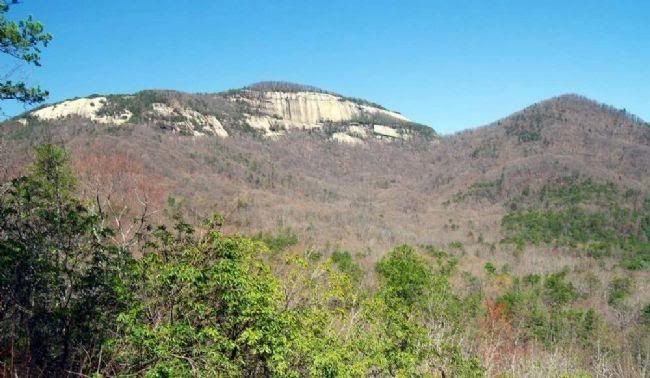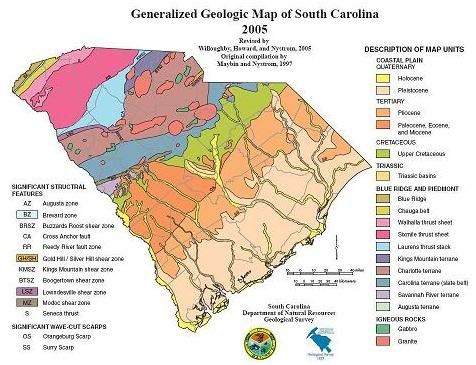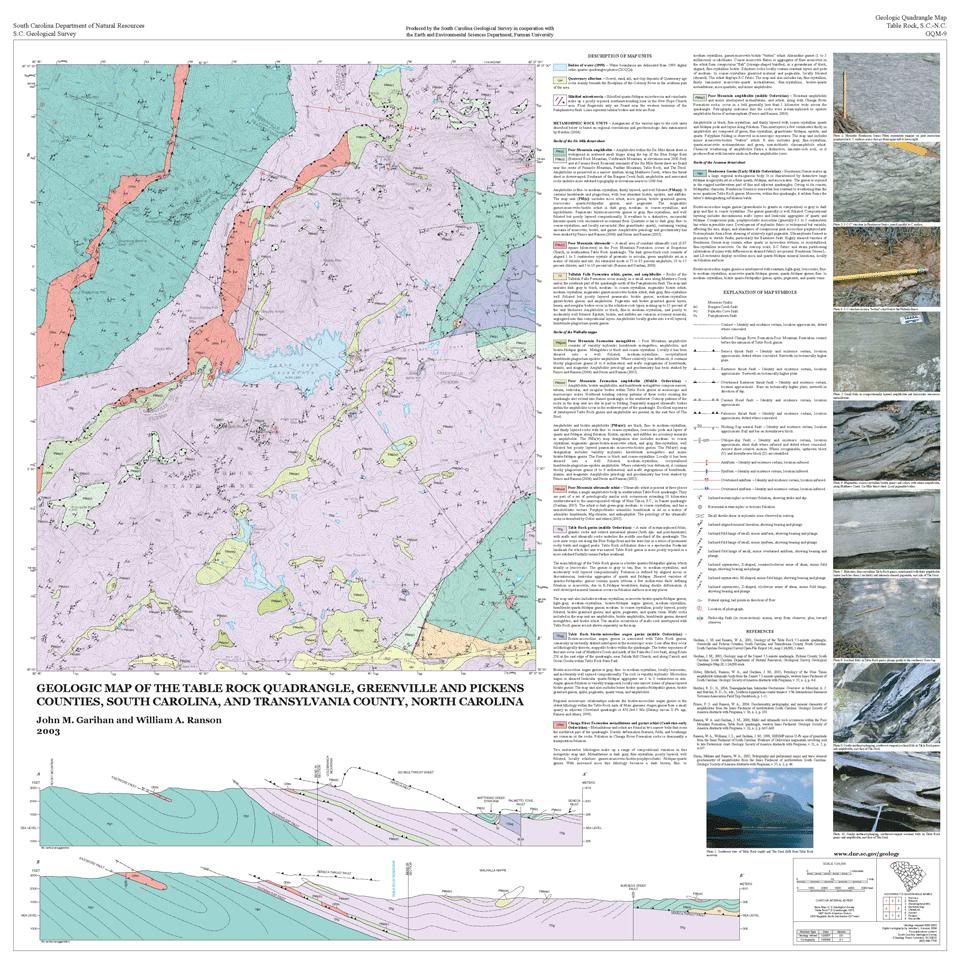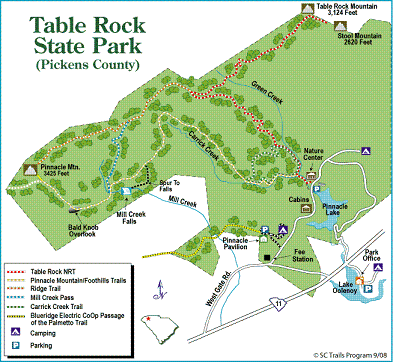
Table Rock Mountain is the most prominent monadnock in SC. It towers majestically above the surrounding countryside, the “monarch of the mountains in this state” according to famed architect Robert Mills (1826).
“Monadnock” is thought by some to be derived from a Native American term for “smooth mountain” or “isolated mountain.” Two other geological terms that are more commonly used worldwide for granite-gneiss mountains that jut abruptly above surrounding landscapes are inselbergs and bornhardts.
Table Rock mountain itself is an excellent example of an “Exfoliation dome.” Exfoliation is a mechanical weathering process “whereby pressure in a rock is released along parallel alignments near the surface of the bedrock and layers or slabs of the rock along these alignments break off from the bedrock and move downhill by gravity.” Exfoliation is seen when an intrusion of igneous or metamorphosed rocks is exposed at the Earth’s surface as a result of tectonic uplift and subsequent erosion of softer rocks above. This releases pressure upwards, but the ongoing pressure from below forces continual expansion. Outer layers of rock crack or sheet along fractures, and the rock layers “peel” off, much like an onion-skin. This produces the dome-like appearance of the rock. “Exfoliation can occur both very slowly or very rapidly….As pressure is released from the surface layer, slabs of rock exfoliate from the dome and move down slope. As they are transported down slope, weathering and erosion processes break the rocks into progressively smaller fragments. Overtime, each new layer that is exposed will eventually exfoliate, from the bedrock.” Other examples of exfoliation domes in the US are Georgia’s “Stone Mountain” and Yosemite’s “Half Dome.”
More about mechanical weathering
More about exfoliation
Processes of Mechanical Weathering
Thus, architect Robert Mills was only partially right about Table Rock when he remarked that “Time alone has made a mark here, and the continual force of the sun’s rays, together with the descending rains, have visibly corroded this apparently imperishable monument of the Deity” (Statistics of South Carolina: Including a View of Its Natural, Civil, and Military History, General and Particular” [Charleston, 1826]: 40).

Beliefs Set in Stone
To log this Earthcache, please visit the site, complete the following activities, and email your answers to the CO:
1. Using the information provided on the "Belief Set in Stone" marker, estimate the elevation here at the site of the “Overlook.” Then double-check your estimate using your GPSr. How close was your estimate?
2. What evidence (if any) of exfoliation is visible from this site?
3. In your opinion, is “The Stool” exfoliated? Is it a monadnock at all?
4. According to Cherokee lore, “an enormous spirit…loomed over this mountain range, his shadow forming the bluish haze. Sha-ka-na-ga, meaning ‘Great Blue Hills of God,’ was the name given this place.” Table Rock itself was imagined by Native Americans and settlers alike as a huge table at which a great giant dined, while being “seated” on Stool Mountain. Using the information provided at this site (and the reproduction of the 19th-century lithograph which you can access thru the link embedded in the cache page), and your own observations, estimate at what elevation the giant’s feet would rest while he feasted.
5. Optional addition to log: Many Geocachers still enjoy webcam caches. New webcam caches are no longer allowed. However, this site provides a distinctive opportunity to add an excellent webcam picture to your log, if you like. Check out the Table Rock State Park Webcam.
The nearby Table Rock State Park HQ provides free Wi-Fi Internet access: take your laptop you so that you and a friend can make a cameo webcam appearance!
We are grateful to the superb managers of Table Rock State Park for permission to locate this Earthcache. Please respect all posted signs and employ “Leave No Trace” practices.
Thanks to Brian Scott for the pictures above.
Access to the “Beliefs Set in Stone” marker at the “Overlook” site requires admission to the state park. (Don’t forget to visit all six historical markers in the park!)
Admissions: $5 - age 16+; $3.50 - SC Seniors; age 15 and younger - free; a $50 annual pass to all inland SC state parks is available.
Office Hours: Mon-Sun, 8am-6pm. Seasonal winter hours, Mon-Sun, 9am-5pm. Days and Hours of Operation: Sun-Thurs, 7am-9pm (extended to 10pm on Fri and Sat). During Daylight Savings Time hours are Sun-Thurs, 7 am-7 pm (extended to 9pm on Fri and Sat).
BRIEF GEOLOGIC HISTORY OF THE AREA
“Formation of the Land”
“The formation of the land itself was a complex and sometimes violent process that stretched over millions of years. Some six hundred million years ago the land…was part of an island off the coast of what eventually became North America. In a massive geological shift about 470 million years ago this island collided with the continent and created a fault line now called the Brevard Zone. Eventually the continent drifted eastward into northwest Africa and became part of a super continent (Pangea). At this stage, 350 million years ago, tremendous heat below the surface of the earth transformed the igneous and sedimentary rock of the region and thrust it upward to form the Blue Ridge Mountains. As North America separated from the larger land mass and settled into its present location, more heat and pressure forced molten material upward into cracks in the earth’s surface. This new material eventually cooled into deposits of granite among the crystalline schists and gneisses that predominate in the region.
“Originally much higher, the southernmost chain of the Blue Ridge Mountains wore down to a height of just over 3000 feet above sea level. Some of this chain are a series of monadnocks (single mountains that tower over the surrounding hills and valleys). To the west in what became Pickens County is an example: Table Rock Mountain. This mountain is naked rock on three sides and was described by architect Robert Mills in 1826 as “a sublime and awful spectacle.” Farther east is another example of a monadnock: Glassy Mountain, whose rocky slopes are wet with water which freezes in winter and “reflects the rays of the sun with dazzling lustre.” Hogback Mountain, a monadnock nearest Spartanburg County, is distinctive for its fertile plateaus. More nearly central to the area is Paris Mountain which is more than a mile in length and meanders east and south until it tapers into Piney Mountain on its southern end. South of the monadnocks, the sloping hills spread into gently rolling countryside.”
From A.V. Huff’s “Greenville: The History of the City and County in the South Carolina Piedmont” (Columbia: USC Press, 1995): 1-2. Used by permission and with gratitude.
GENERALIZED SC GEOLOGIC MAP

“Regional Geologic Relationships”
“The Appalachian Inner Piedmont block of North and South Carolina is a terrane of polyphase deformed metamorphic rocks of middle to upper amphibolite grade that were subjected to several major Paleozoic compressional and Mesozoic extensional orogenic events. The terrane is noted for its complex structure of fold nappes and stacked thrust sheets (Griffin, 1974; Nelson and others, 1998; Hatcher, 1999); widespread distribution of a perplexing variety of Paleozoic granitoid gneisses; and poor, commonly saprolitic, exposure. The Inner Piedmont block lies between the eastern Blue Ridge province to the northwest and the Carolina terrane to the southeast (Figure 1 inset), and it is separated from them by the Brevard fault and the central Piedmont shear zone, respectively. The Inner Piedmont is related closely to the eastern Blue Ridge province in terms of stratigraphy and metamorphic grade, although tectonically disconnected from it (Hatcher, 1993, 1998, 1999). Together, the two form the Piedmont terrane, of which the origin and accretion history remain controversial. Unlike the western Blue Ridge province, of which the affinity with ancestral North America or Laurentia (Hatcher and Goldberg, 1991) seems clear, the Piedmont terrane is viewed by some as an ancient margin of North America, part of one or more accretionary prisms (Hatcher, 1987; Rankin, 1988). Others have suggested that it is a suspect terrane welded onto the North American continent during Early to Middle Ordovician time (Horton and others, 1989; Williams and Hatcher, 1982, 1983).
Four major formations occur in the area (Garihan, 1999a)….They lie within the Six Mile thrust sheet, which overlies Walhalla nappe and is separated from it by the Seneca fault (Sugarloaf Mountain fault;…). Lithologic units in the Six Mile thrust sheet include the Tallulah Falls Formation and overlying Poor Mountain Formation. The Tallulah Falls Formation consists of biotite granitoid gneisses, migmatitic biotite-muscovite gneiss and schist, muscovite-biotite metagraywacke and minor calc-silicate gneiss. The Poor Mountain Formation is a series of interlayered garnet mica schist and amphibolite with less abundant metaquartzite and biotite gneiss. Below the Seneca fault in the Walhalla nappe…[is] the Table Rock Plutonic Suite biotite gneiss (a finely crystalline, finely layered biotite gneiss of granitic composition, …referred to as Table Rock gneiss).
From Bill Ranson and Jack Garihan, “Geology of the Inner Piedmont in the Caesars Head and Table Rock State Parks Area, Northwestern South Carolina: 2001 Carolina Geological Society Field Trip,” SC Geology 43 (2001):73-86 (selected). Used by permission and with gratitude; emphasis added.
TABLE ROCK QUADRANGLE GEOLOGIC MAP

Search for geologic maps from the SC Geological Survey and the SC Department of Natural Resources.
Table Rock Hiking Trails
Some of the premier hiking trails in the southeastern US are located in the northwest corner of SC, which includes the Mountain Bridge Wilderness area, Jocassee Gorges, and five state parks (Caesars Head, Devils Fork, Jones Gap, Keowee-Toxaway, and Table Rock). A crown jewel of these trails is the Table Rock National Recreation Trail, featuring a very strenuous trek (2000+ foot ascent) to a breathtaking view of the entire area from the summit of this classic “exfoliation dome.”

Table Rock State Park features a wide variety of activities, especially the wonderful hiking trails.
Two of the park’s trails feature exceptional geologic exposures that will intrigue Earth Science experts and duffers alike:
Carrick Creek Trail
“Folds in Table Rock gneiss and amphibolite of the Walhalla nappe occur at Carrick Creek along the Table Rock trail…. [and at] Green Creek, where biotite augen gneiss interlayered with Table Rock gneiss is well exposed.” (Ranson and Garihan, p. 74-75; also “Gneisses at Carrick Creek and Green Creek”, pp. 80-82).
Table Rock NRT
The “climb along the Table Rock trail, which crosses several klippen of the Six Mile thrust sheet at Panther Gap and Table Rock proper (elevation 3124 ft or 952 m). There Poor Mountain Formation rocks lie at the extreme northwestern erosional edge of the Six Mile thrust sheet, at elevations of 2400 to 3100 feet. Polyphasedeformed, north-plunging folds in Table Rock gneiss and pegmatite are well exposed at extensive pavements on the west side of Table Rock at Governors Rock, located below the summit of the exfoliation dome. For igneous petrologists and structural geologists these features are well worth the exertions of an exhilarating climb to the top.” (Ranson and Garihan, p. 75).
Info on Trails
Hiking Trails: The extensive trail system carries hikers past streams and waterfalls to the top of Table Rock and Pinnacle mountains. Table Rock is an access point to the Foothills Trail.
Hiking trails close ½-hour before dark. Overnight camping is not permitted on park trails. Please keep all dogs on 6ft leash at all times. Plan ahead and use all safety precautions.
TOP, LOF (Take Only Pictures, Leave Only Footprints)
FTF congratulations to rods&ropes!
STF congratulations to 2Jeeps2Jacks!